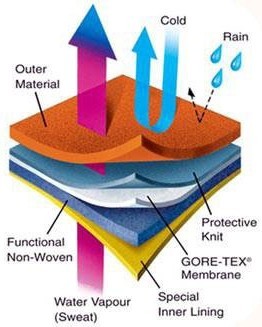Breathable vs. Non-Breathable Waders for Electrofishing
To understand why so many people have been electrified while electrofishing with breathable waders, it is important to understand how breathable and non-breathable waders function.
Non-Breathable Waders
Solid, non-porous layers of material are found on waders made with PVC, Rubber, and/or Neoprene. There are no micropores to allow vapor, water, air, sweat, electrons, or other particles to pass through. Of course, should you develop holes in your waders, you are creating pathways for transfer of particles from one side of your waders to the other, including electricity (the movement of electrons). Therefore, it is always advised to immediately patch all holes in your waders, no matter how small the hole, to prevent being electrified. Years of use have demonstrated that at the voltages used with electrofishing, non-breathable waders act as an effective electrical insulator. Similarly, proper rubber gloves (lineman gloves), are an additional tool that are strongly recommended to provide further electrical insulation.
Breathable Waders
Gore-Tex, and other "Breathable" textiles, are not a solid layer. The textiles have purposefully designed micropores that are larger than water vapor (700 times larger), but much smaller than water droplets (20,000 times smaller). (Source)
As you sweat inside of your breathable waders, the moisture is in vapor form, and is able to penetrate through the porous material and vacate your waders, making them "breathable". Whereas, the water droplets on the outside of your waders force against the porous material, but are too large to penetrate.

As the day transpires, you continue to sweat. As some of the sweat vapors inside your waders collect to form droplets, your clothes become increasingly saturated with sweat. Additionally, as you go into cool water, the vapor cools and more easily collects as droplets that stay stuck inside your waders. Further, when you walk into deeper water, the pressure of water on the outside of your waders forces out the air on the inside of your waders (wafting the wonderful aroma past your face!). In turn, this pushes the saturated fabric of the waders tighter against your clothes and skin. Air is a much better insulator than water. Unfortunately, your sweat, which contains a lot of electrolytes, is an excellent conductor, and therefore begets the ultimate reason why breathable waders are not recommended.
Electricity
We have all heard that "Electricity takes the path of least resistance." What you may not be aware of is that when breaking it down to a simple form, electricity is the movement of electrons. Guess what is smaller than water vapor in size? Electrons!
As the layers of materials in your breathable waders become saturated with sweat on the inside and water on the outside, liquids press against either side of the porous layer. As mentioned, the sweat (salt water) on the inside of your waders is far more conductive than the freshwater around it, and as you go into deeper water and force the air out of your waders, the tiny electrons pass through the porous "breathable" layer, and exploit a pathway through your waders and eventually your body. This results in you receiving an electrical shock.
Take Home Message
Can you electrofish with breathable waders and not get electrified? You can, until you can’t! With dry clothes on under your breathable waders and electrofishing in very shallow water, one can electrofish all day without being electrified. Unfortunately, this provides a lot of anecdotal evidence where people profess "I have never been shocked while wearing breathable waders, so I don’t see what the big deal is!".
However, not everyone electrofishes under those "ideal" conditions. In more diverse conditions, as you sweat and enter water about knee depth, the likelihood of becoming "shocked" increases, especially if you are electrofishing in low conductivity water and/or have the electrofisher operating at higher voltages (electrical pressure).
Should one of the electrodes get close to your legs while electrofishing with breathable waders, you will feel an even greater "shock" because the electric field is strongest (most dense) in closer proximity to the electrodes. Additionally, it seems to get people in the sensitive skin on the back of the knee, which in turn, increase the risk of falling. We have found that falling while electrofishing has led to far further injuries than being electrified. So, don’t get electrified, and stay on your feet to stay safe!
Safety is a Priority
Smith-Root makes your safety a priority. We designed our backpack electrofishers to have the greatest number of safety standards in the world. We know that you work in remote regions and protect some of our most vulnerable natural places and organisms. Therefore, we aim to also protect you…the protectors. Please know that we understand that non-breathable waders can be less comfortable than breathable waders in terms of sweat, heat, and long walks. But, we’d much prefer to know that you made it home safe and completed your scientific/management objectives while minimizing/eliminating the risk of being electrically shocked.
Therefore, EXPERTS DON’T WEAR BREATHABLE WADERS!
Please look for PVC lined waders or neoprene waders. Additionally, wear dry clothing underneath your waders and proper rubber gloves on your hands. Finally, wear proper footwear to minimize the chance of falling.